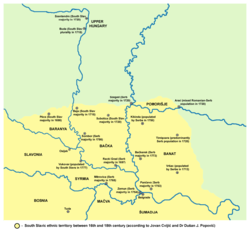Rascians


Rascians (Serbian: Raci or Раци, also Rascijani or Расцијани; Hungarian: Rác, (pl.) Rácok; German: Ratzen, Raize, (pl.) Raizen; also Ratzians, Rasciani and Natio Rasciana) was an exonym in the Middle Ages and the early modern times that designated Serbs, or sometimes, in a wider perspective, all South Slavs, especially Bunjevci and Šokci.[4] The name, primarily used by Hungarians and Germans, derived from the pars pro toto "Raška" (Rascia), a region of the medieval Serbian principality.[5] Because of the large number of Serbs who migrated from Serbia (which was also known as Rascia) to the Pannonian Plain from the 14th century, the southern parts of the Pannonian Plain were also named Rascia (Raška or Рашка in Serbian, Ráczság or Ráczország in Hungarian and Ratzenland or Rezenland in German).
History
Since the 15th century, the Serbs made up a large percentage of the population on the territory of present-day Vojvodina. Because of this, many historical sources and maps, which were written and drawn between 15th and 18th centuries, mention the territory of present-day Vojvodina under the names of Rascia (Raška, Serbia) and Little Rascia (Mala Raška, Little Serbia). The name Rascia was also used to designate parts of Slavonia populated by Serbs.
One sixteenth-century Italian account of the Ottoman Empire said that "the Rascians were people from Serbia and Rascia who had fled from the Turks and now lived to the north of the Danube".[6]
According to one historical record from 1543, Timişoara and Arad were located in the middle of Rascia (in medio Rascionarum).[7] According to the same record, the main language spoken in Banat in that time was Serbian and Banat was named the Little Rascia, while 17 Serbian monasteries existed in Banat in that time.[8]
In seventeenth-century Habsburg usage, the term "Rascian" referred most commonly to the Serbs who lived in Habsburg territory, then more generally to Orthodox Serbs, wherever they lived, and then more generally still to speakers of Serbian or Serbo-Croat.[9] The Emperor's so-called "Invitatorium" in April 1690, for example, was addressed to Arsenije as "Patriarch of the Rascians", but Austrian court style also distinguished between "Catholic Rascians" and "Orthodox Rascians".[10]
In official Habsburg documents from the 18th century the Serbs of Habsburg Monarchy were mentioned as Rasciani ("Rascians"), Natio Rasciana ("Rascian nation"), Illyri ("Illyrians") and Natio Illyrica ("Illyrian nation").[11]
During the Kuruc War (1703–1711) of Francis II Rakoczi, the territory of present-day Vojvodina was a battlefield between Hungarian rebels and local Serbs who fought on the side of the Habsburg Emperor. Darvas, the prime military commander of the Hungarian rebels, which fought against Serbs in Bačka, wrote: We burned all large places of Rascia, on the both banks of the rivers Danube and Tisa.
When the representatives of the Vojvodinian Serbs negotiated with the Hungarian leader Lajos Kossuth in 1848, they asked him not to call them Raci, because they regard this name insulting, since they have their national and historical endonym – Serbs.
The initial name of the city of Novi Sad (Ratzen Stadt - Rascian City, Serb City) has also derived from the name Rascians. The Tabán quarter of Budapest was also called Rácváros in the 18th-19th centuries because of its significant Serb population.
Since the 19th century, the term Rascians is no longer widely used.
See also
- Rác (surname)
- Serbs
- Serbs in Vojvodina
- Rascia
- History of Serbia
- History of Vojvodina
- Habsburg-occupied Serbia
References
- ↑ Rascia, Časopis o Srbima u Vojvodini, Godina I, Broj 1, Vršac, Maj 1996.
- ↑ Letopis Matice srpske: Томови 205-210, Matica srpska (Novi Sad, Serbia) - 1901.
- ↑ Letopis Matice srpske: Томови 205-210, Matica srpska (Novi Sad, Serbia) - 1901.
- ↑ Trócsányi, Zs. (1985). "The legal status of the Bulgarian colonies of Transylvania (1690-1848)". Etudes historiques hongroises: p. 542.
- ↑ [Projekat Rastko] Jovanka Kalic - Rascia - The Nucleus of the Medieval Serbian State
- ↑ Noel Malcolm, Kosovo - A Short History, Pan Books, London, 2002, page 145.
- ↑ Rascia - časopis o Srbima u Vojvodini, godina I, broj 1, Vršac, Maj 1996, page 2.
- ↑ Rascia - časopis o Srbima u Vojvodini, godina I, broj 1, Vršac, Maj 1996, page 2.
- ↑ Noel Malcolm, Kosovo - A Short History, Pan Books, London, 2002, page 145.
- ↑ Noel Malcolm, Kosovo - A Short History, Pan Books, London, 2002, page 145.
- ↑ Srbski letopis za godinu 1866, Matica srpska, Novi Sad, 1867, page 250.
Sources
- Drago Njegovan, Prisajedinjenje Vojvodine Srbiji, Novi Sad, 2004.
- Tutorov, Milan (1991). Mala Raška a u Banatu. Zrenjanin.
- Rascia, Časopis o Srbima u Vojvodini, year I, number 1, Vršac, May 1996.
- Lazo M. Kostić, Srpska Vojvodina i njene manjine, Novi Sad, 1999.
External links
- Map from 1661 showing name Rascia in Banat and Syrmia
- The Serbs outside Serbia - a preservation of cultural identity
- Jaša Tomić - Monografija mesta
Maps
-

Map from 1590, in which name Rascia is located in Banat
-

Map from 1645, in which name Rascia is located in Banat
-

Map from the first half of the 17th century, in which name Rascia is located in Banat
-
Map of Banat with the name Rasciani
-

Map of Novi Sad (Ratzen Stadt) from 1745
-

Map from 1609, showing name Rascia in Slavonia
-

Map from 1643-50, showing name Rascia in Slavonia


